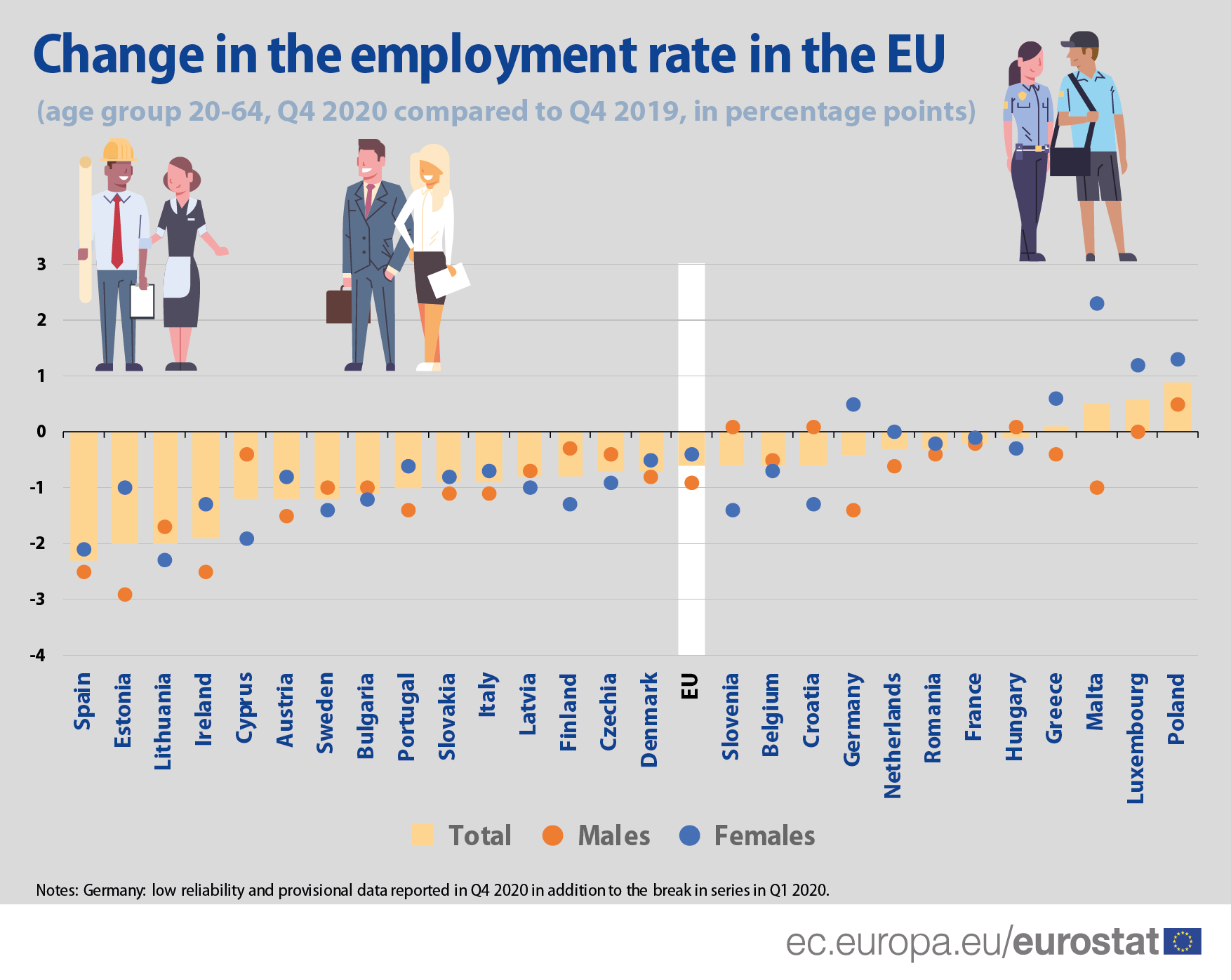
Since the first quarter of 2020, the European labour market has had to cope with the COVID-19 pandemic. Many European Union (EU) Member States implemented measures such as short-time work or financial support to enterprises to dampen the impact of the health crisis on employment. This might have helped to limit mass dismissals to a certain extent. However, people who should have entered the workforce or been maintained in employment through the renewal of their temporary contract might have been directly impacted by the downturn in economic activities and the shutdown of businesses or public entities.
In the fourth quarter of 2020, 188.7 million people or 72.6% of the total EU population aged 20-64 were employed compared to 186.6 million or 71.7% in the second quarter of 2020 and 191.4 million or 73.2% in the fourth quarter of 2019.
EU male employment decreased by 1.7 million from the fourth quarter of 2019 to the fourth quarter of 2020, a drop of 0.9 percentage points (pp) in the employment rate (from 79.1% to 78.2%), while female employment went down by 1.0 million, a cut of 0.4 pp in the employment rate (from 67.4% to 67.0%) over this period.
Highest drops in employment rate in Spain, Estonia and Lithuania
Almost all EU Member States, with the exception of Poland, Luxembourg, Malta and Greece, recorded a decrease in their employment rates between the fourth quarter of 2019 and the fourth quarter of 2020, with falls of more than 2 pp being recorded in Spain, Estonia and Lithuania.
Source dataset: lfsi_emp_q
Temporary employment at the end of 2020 still below 2019 levels, men hit harder
Temporary contracts accounted for 10.6% of total EU employment in the last quarter of 2020, or slightly more than one out of every ten employed people in the EU, compared to 11.7 % in the fourth quarter of 2019.
Since the start of the series, temporary employment trend shows a difference in genders, with female employees having a higher share of such contracts than their male counterparts. In 2020, the share of temporary employment dropped by 1.3 percentage points (pp) for both genders in the second quarter compared to the first quarter of 2020, followed by a slow recovery in the next two quarters. However, the recovery rate was lower for temporary employment of men than for women in both last two quarters of 2020.
Despite the growth of temporary contracts in the fourth quarter, the numbers at the end of 2020 were still below the 2019 values; 1.1 pp lower than in Q4 2019 for men and 0.9 pp for women.
Source dataset: lfsi_pt_q
Notes:
- Figures are based on seasonally adjusted quarterly results from the European Labour Force Survey (EU-LFS).
- Germany: from the first quarter of 2020 onwards, the Labour Force Survey (LFS) has been integrated into the newly designed German microcensus as a subsample. Unfortunately, for the LFS, technical issues and the COVID-19 crisis have had a large impact on the data collection processes, resulting in low response rates and a biased sample. For this reason, the full sample of the whole microcensus has been used to estimate a restricted set of indicators for the four quarters of 2020 for the production of LFS Main Indicators. These estimates have been used for the publication of German results, but also for the calculation of EU and EA aggregates. For more information, see here.
- For more information also see Eurostat “Statistics Explained” articles on quarterly data on employment: Employment and Employment in detail.
To contact us, please visit our User Support page.
For press queries, please contact our Media Support.



